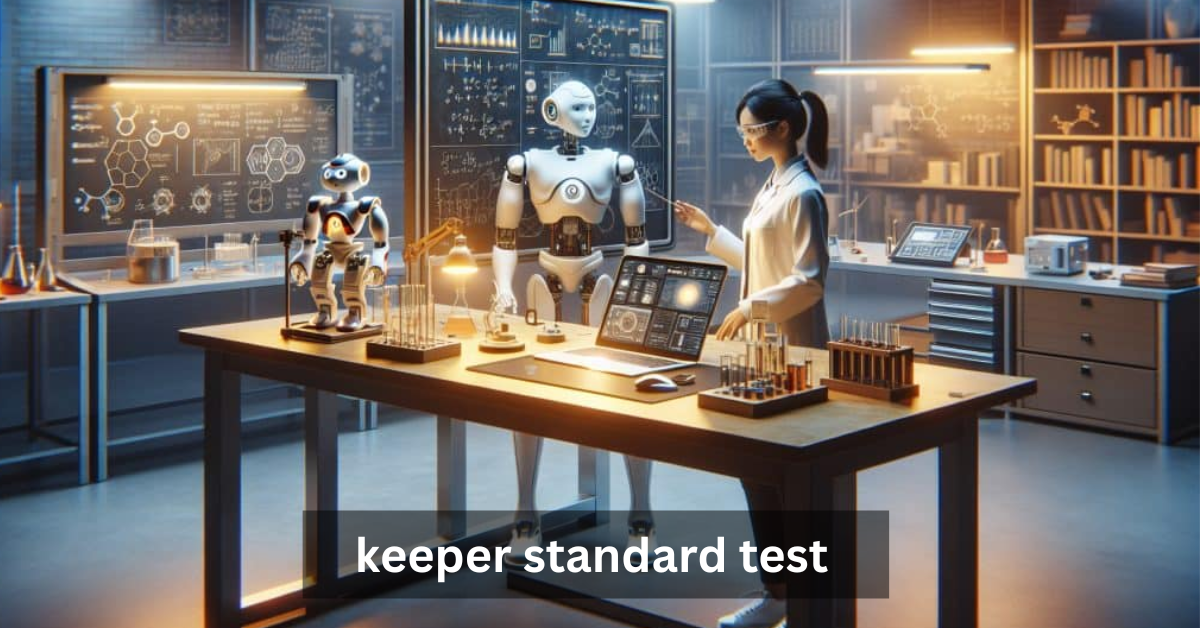In the world of soccer, goalkeepers are the last line of defense and often the unsung heroes of the game. Their unique position demands a combination of physical agility, technical expertise, tactical awareness, and mental resilience. The Keeper Standard Test has emerged as a comprehensive tool to evaluate these multifaceted skills, offering goalkeepers a structured way to measure and improve their performance. In this article, we delve deep into the Keeper Standard Test, its components, benefits, and the ways it shapes the future of goalkeeping.
What is the Keeper Standard Test?

The Keeper Standard Test is a holistic evaluation designed specifically for goalkeepers to assess their capabilities across four critical areas: physical fitness, technical skills, tactical understanding, and mental toughness. Unlike traditional fitness tests, this test focuses on the unique demands of goalkeeping, such as reflexive agility, shot-stopping techniques, and decision-making under pressure. By incorporating both physical and psychological elements, the Keeper Standard Test provides a complete picture of a goalkeeper’s readiness for competitive soccer.
This test has gained recognition in professional soccer circles and is frequently used by coaches, training academies, and even professional organizations like FIFA and UEFA. It serves not only as a benchmark for performance but also as a tool for self-assessment and goal setting. Aspiring goalkeepers use it to understand their strengths and identify areas for improvement, while seasoned professionals rely on it to maintain peak performance levels.
The Importance of the Keeper Standard Test in Goalkeeper Development
Goalkeeping is a specialized role that requires continuous development. The Keeper Standard Test plays a pivotal role in this development by providing an objective measure of a goalkeeper’s skills. It goes beyond the basic drills and exercises, simulating real-game scenarios to evaluate how goalkeepers perform under pressure. This is crucial because goalkeepers often face high-stakes situations where split-second decisions can determine the outcome of a match.
For young and aspiring goalkeepers, the test offers a structured pathway to growth. It helps them understand the specific demands of the position and provides actionable feedback to improve their game. For professionals, it ensures that they remain competitive by identifying any skill gaps and areas requiring attention. Moreover, the Keeper Standard Test empowers coaches to design targeted training programs that address individual needs, fostering both personal and team success.
History and Evolution of the Keeper Standard Test
The origins of goalkeeper testing can be traced back to the early days of professional soccer when simple drills were used to gauge a player’s reflexes and agility. Over time, as the game evolved, so did the understanding of what makes a great goalkeeper. The Keeper Standard Test emerged as a modern solution to meet the growing demands of the position.
Initially, goalkeeper assessments focused primarily on physical attributes such as speed, strength, and reflexes. However, advancements in sports science and analytics revealed the importance of incorporating technical, tactical, and mental components into evaluations. Today, the Keeper Standard Test reflects these insights, offering a comprehensive and nuanced approach to goalkeeper development. It integrates cutting-edge technologies like motion capture, virtual reality, and AI-driven analytics to provide precise measurements of performance.
Core Components of the Keeper Standard Test
The Keeper Standard Test is structured around four main components, each designed to evaluate a critical aspect of goalkeeping performance:
Physical Fitness and Agility Assessment
Physical fitness is the foundation of a goalkeeper’s performance. This component measures attributes such as endurance, agility, reflexes, and strength. Goalkeepers are required to perform drills that simulate match conditions, including lateral movements, quick dives, and high jumps. These exercises test their ability to maintain peak performance throughout a game.
Technical Skills Evaluation
Technical proficiency is essential for effective goalkeeping. The test includes drills that assess ball-handling, diving techniques, and distribution skills. Goalkeepers are evaluated on their ability to catch, punch, and parry shots while maintaining control and precision. Distribution exercises focus on accuracy in throwing and kicking the ball to initiate counterattacks or maintain possession.
Tactical Understanding and Game Awareness
A goalkeeper’s tactical understanding can often be the difference between a clean sheet and conceding goals. This component evaluates their ability to read the game, position themselves effectively, and communicate with teammates. Goalkeepers are assessed on their decision-making in various scenarios, such as organizing the defense during set pieces or anticipating the opponent’s moves.
Mental Resilience and Pressure Handling
Goalkeepers face immense pressure during matches, and their mental resilience can significantly impact their performance. This component tests their ability to stay focused, manage stress, and recover from mistakes. Exercises often include high-pressure simulations where goalkeepers must make quick decisions in challenging situations, helping them build confidence and composure.
How the Keeper Standard Test is Conducted
The Keeper Standard Test is typically conducted in a controlled training environment, ensuring consistency and accuracy in evaluations. The process begins with a warm-up session to prepare goalkeepers for the physical demands of the test. Experienced coaches administer the test, guiding goalkeepers through a series of drills and exercises designed to simulate match conditions.
Each component of the test is scored using a standardized system, with detailed feedback provided afterward. This feedback highlights strengths, identifies areas for improvement, and offers actionable recommendations for further development. The entire process usually takes 60-90 minutes, depending on the level of detail and the number of participants.
Benefits of the Keeper Standard Test
The Keeper Standard Test offers numerous benefits for goalkeepers, coaches, and training programs alike:
- For Aspiring Goalkeepers: It provides a clear roadmap for skill development, helping young players understand what it takes to succeed at higher levels.
- For Professional Players: It ensures that they remain competitive by offering insights into their performance and highlighting areas for improvement.
- For Coaches and Training Programs: It serves as a valuable tool for designing personalized training plans that address the specific needs of each goalkeeper.
By fostering a culture of continuous improvement, the Keeper Standard Test contributes to the overall advancement of goalkeeping standards in modern soccer.
Preparing for the Keeper Standard Test
Preparation is key to performing well in the Keeper Standard Test. Goalkeepers should focus on the following areas:
Physical Conditioning Tips
Build endurance and agility through cardio exercises, strength training, and reflex drills. Incorporate activities like sprints, ladder drills, and plyometric exercises to improve explosive movements.
Drills to Improve Technical Skills
Practice catching, diving, and distribution techniques. Work on ball control and accuracy to enhance your overall technical proficiency.
Building Mental Toughness
Use visualization techniques, mindfulness exercises, and stress management strategies to build mental resilience. Simulate high-pressure scenarios during training to prepare for real-game situations.
Analyzing Tactical Scenarios
Study match footage to understand tactical setups and decision-making processes. Practice organizing the defense and communicating effectively with teammates.
Real-World Applications of the Keeper Standard Test
The Keeper Standard Test has been embraced by professional soccer academies and training programs worldwide. Many top goalkeepers, such as Manuel Neuer and David de Gea, have benefited from similar assessments, using them to refine their skills and maintain peak performance levels.
Incorporating elements of the Keeper Standard Test into regular training routines helps goalkeepers stay ahead of the competition. It also provides a framework for academies to develop talent and ensure that their players meet the demands of modern soccer.
Challenges and Limitations of the Keeper Standard Test
While the Keeper Standard Test is a valuable tool, it is not without its challenges. One potential issue is the possibility of bias in evaluations, as assessments are often conducted by individual coaches with varying preferences. Additionally, the test may not fully capture all aspects of a goalkeeper’s abilities, particularly in real-game scenarios where external factors like crowd noise and emotional pressure come into play.
To address these limitations, it is important to supplement the test with ongoing match assessments and incorporate advanced technologies like motion capture and AI-driven analytics.
The Future of the Keeper Standard Test

As technology continues to advance, the Keeper Standard Test is likely to evolve. Innovations such as virtual reality goalkeeper training, AI-driven soccer analytics, and neurofeedback in sports are expected to play a significant role in enhancing the test’s accuracy and effectiveness. These advancements will provide deeper insights into a goalkeeper’s biomechanics, reaction times, and decision-making processes, paving the way for more personalized and precise evaluations.
Conclusion
The Keeper Standard Test is a game-changer for goalkeepers, offering a comprehensive framework to assess and improve their skills. By focusing on physical, technical, tactical, and mental components, the test equips goalkeepers with the tools they need to excel in modern soccer. Whether you are an aspiring player or a seasoned professional, embracing the Keeper Standard Test can unlock your full potential and set you on the path to success.
Frequently Asked Questions
How long does the Keeper Standard Test take?
The test typically takes 60-90 minutes, depending on the complexity and number of drills.
Who can take the Keeper Standard Test?
The test is suitable for goalkeepers of all levels, from amateurs to professionals.
What are the main skills tested?
The test evaluates physical fitness, technical skills, tactical understanding, and mental resilience.
How to benchmark progress with the test?
Regularly retake the test to track improvements and set new performance goals.
Stay in touch to get more updates & alerts on Creative Released! Thank you



